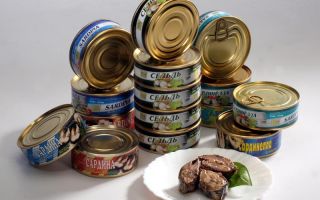Content
- 1 The history of the emergence of canned fish
- 2 Types of canned fish
- 3 Composition of canned fish
- 4 Calorie content of canned fish
- 5 Is there a benefit in canned fish
- 6 Is it possible for canned fish for pregnant and lactating
- 7 Canned fish for children
- 8 Is canned fish useful for losing weight
- 9 Canned fish in cooking
- 10 Why canned fish are harmful
- 11 Contraindications to use
- 12 How to choose canned fish in the store
- 13 How to store canned fish properly
- 14 Conclusion
It is difficult to find a person who, at least once in his life, has not tasted fish, hermetically sealed in a jar. Such a product is easy to consume, you can take it with you on the road, have a snack at any time. The assortment of seafood is extensive, growing every year. But the benefits and harms of canned fish have been disputed since the first factory opened.
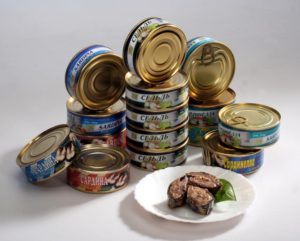
The history of the emergence of canned fish
The history of the development of canned food begins in ancient times:
- The ancient Egyptians were the first to preserve food. They sealed clay vessels containing a roast duck in olive oil with a special resin. Such canned food was discovered by archaeologists in the tomb of Tutankhamun. It is noteworthy that after lying for millennia, the product remained edible.
- For modern canned food, the world should thank the chef from Paris Nicolas François Appert, who invented a way to store food for a long time and founded the first cannery.
- But the French could not hold their positions, the British got down to business seriously. Instead of glass jars for packaging canned food, they used tin containers.
- Later, the Americans became interested in the technology, they took tin cans for packaging.
- Scientifically substantiated the methods of canning Pasteur.
Since then, the production methodology has changed a lot, new technologies and opportunities have appeared. But the base still remained the same.

Types of canned fish
Canned fish are of different types:
- Natural... Whole fish from salmon and sturgeon breeds is used for production. Of the additives, only salt is present in them. The product is not subjected to any processing, only sterilized.
- Culinary... This canning method is applied to most types of fish. Before sterilization, smoking, salting or pickling is performed.
- Preserves... For making, take the smallest fish. Sterilization is not carried out, therefore canned food is stored for 2-3 weeks.
- Other canned fish... The fish liver is closed in jars. These foods are very healthy and high in calories.
- Caviar... Most often, consumers pay attention to caviar of cheap fish varieties. The sturgeon and salmon delicacy is expensive.
- Pastes, sprats, fish meatballs... Inexpensive types of fish are used for manufacturing.
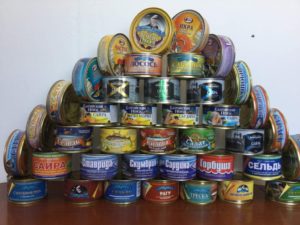
Composition of canned fish
The parameter depends on the type of canned food and how they were produced. In each jar, besides the main product, there are spices and herbs.
Natural canned food can contain fish broth, jelly. Vegetable fat is added to the snack bars.
Vitamin and mineral components are also different, depending on the type of fish and its properties. It contains different amounts of vitamins A and D, B12, A, C and B1, PP.
Calorie content of canned fish
Depending on the type, all canned fish have a different calorie content per 100 grams - from 88 to 350 Kcal. BJU ratio (approximate):
- 70 kcal proteins;
- 18 kcal of fat;
- no carbohydrates.
Is there a benefit in canned fish
No one will dispute the fact that fresh fish itself has beneficial properties. This product should be in the diet of every family. But about the benefits, or dangers of canned fish, the controversy still continues.
The fact is that the product is heat treated. Many people believe that vitamins and nutrients can be lost. In fact, the properties of fish are not lost during canning, the original composition of the raw material simply changes.
Canned fish contains phosphorus and acids. Calcium and magnesium are stored in the product. High in lycopene, antioxidants. When exposed to heat, useful compounds do not disappear, only the composition of the original raw material changes.
Eating canned fish is good for the brain and the endocrine system. It is recommended to use the product with great physical exertion, with heart problems.
The benefits of canned fish on trips and business trips, when there is no way to cook hot food, are undeniable.
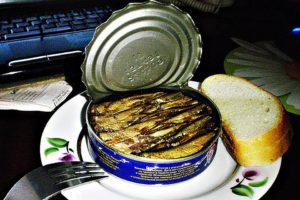
Is it possible for canned fish for pregnant and lactating
Despite the beneficial properties, canned fish is not advisable for women who are expecting a baby. The fact is that the production technology involves the addition of some antibacterial drugs and chemicals. All of them can cause allergies not only in the mother, but also in the fetus.
It is not recommended to introduce canned fish into the diet of a nursing mother in the first months of a baby's life. Only after 2-3 months can you eat a piece, but at the same time observe the child's reaction. If there are signs of allergy, then the fish will have to be abandoned until the end of the feeding.
Canned fish for children
Pediatricians do not recommend giving fish from a can to small children under 3 years old. In the future, it can be used, but only in small quantities. The fish should not be expired. In addition, you need to monitor how the body reacts to the new product, whether it will give an allergic reaction.
Is canned fish useful for losing weight
If a person is on a diet, he can include canned fish in the diet. But it should be noted that the calorie content of foods is different:
- mackerel - 200-317 Kcal;
- sprats - 363 Kcal;
- cod liver - 653 Kcal.
So you have to give up oily fish. You must carefully read the information on the label so as not to harm yourself by gaining extra pounds.

Canned fish in cooking
Fish from cans is widely used in cooking. It can be used as a snack by placing the contents on a plate.
There are also a lot of fish salads. They add, depending on the recipe:
- green peas, corn;
- carrots, beets, onions;
- garlic, rice;
- fresh and pickled cucumber;
- potatoes, eggs.
One of the most popular is the "Mimosa" salad, and in different variations. Fish is added to minced meat for making rolls, pancake fillings. Delicious fish cakes are baked. Many people like saury or mackerel ear, fish cakes.
Why canned fish are harmful
Canned fish can bring not only benefits, but also harm to the body:
- The product is high in salt and spices. These are substances that increase cholesterol levels, retain fluid in the body, which can cause swelling.
- Excess salt is harmful and has a negative effect on the condition of the blood vessels.
- In addition to salt and spices, various chemical additives are used in the preservation of seafood. Therefore, canned fish is not recommended for gastritis and other gastrointestinal diseases.
It should be understood that fresh fish is healthier than canned food. But this is a private matter for consumers.
Canned fish and botulism
Often, in violation of the canning technology, improper storage, as well as in expired banks, there is a dangerous stick for health - botulism clostridium. In the best case, a person who has been treated to an infected fish may experience nausea, abdominal cramps, and diarrhea. At worst, death is possible.
Contraindications to use
Canned fish is contraindicated not only for pregnant and lactating mothers and children under 3 years old. For some serious illnesses, it also harms:
- with renal failure;
- at high pressure;
- osteoporosis.

How to choose canned fish in the store
The choice of fish products must be approached carefully. It is important to look at the appearance of the can, the date and place of manufacture, and the assortment code.
Bank appearance
Before paying for a purchase, you need to take the bank in hand and examine it from all sides:
- Jars with defects, bulges, dents and rust are best left on the counter. All these disadvantages are associated with violation of storage and transportation rules. The contents of the jars can be not only harmful, but hazardous to health.
- Next, inspect the label. This element should be flat and firmly glued to the jar. If the label is loose, this may be the reason for improper shipping. Or, even worse, canned food is made by fake factories, where no technology is followed.
- The next point, which should not be missed, so as not to experience the harm from canned fish, for example, in oil, whether the can is swollen or not, instead of the benefits. To do this, you need to lightly press the middle of the lid, and then release. If there is no deflection, then canned food is suitable for eating.
- To understand whether there is a lot of fish in the jar, just shake the jar. If liquid gurgles in it, then you will have to pay for water.
Date of manufacture and address
Only canned food can be useful, for the manufacture of which fresh fish was used. Therefore, when buying after visual inspection, you need to find when the product was released from the factory.
Examples:
- If you need canned pink salmon, then it takes several months to produce it (June-August). If the canned product was produced at a different time, then the tanks contain previously thawed fish or pink salmon, which is preparing for spawning. Of course, such canned food will not harm health, but there is also little benefit from them.
- Many people love canned food made from juicy and oily fish. The date of manufacture of such products is the autumn months.
- When buying saury, it should be borne in mind that for some time after closing in cans, it gains flavor properties due to seasonings and spices. Therefore, it is better to buy saury 2-3 months after canning.
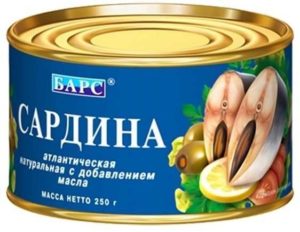
Assortment code
Currently, canned fish is made according to technical specifications (TU) or standards (GOST). Unfortunately, in recent years, many dealers have appeared supplying counterfeit products to the market. It is not only harmful to health, but also dangerous, since all possible requirements and technology are violated during manufacture.
Therefore, you need to know how to distinguish a useful product from a fake one:
- A stamp is applied to the lid of the can at the factory. On it you can find out when and at what time canned food was released.
- The stamp can be embossed or painted. On factory cans, paint cannot be erased.
- In GOST canned food, symbols resemble Braille signs, they can be "read" with your fingers. In counterfeit products, the badges have no volume.
- High-quality and healthy canned fish have the letter P among the symbols, indicating that the manufacturer is related to the fishing industry.
From the label, if you read it skillfully, you can find out what is inside the jar. 1 or 3 signs are in the second row on the cover:
- 308 - saury;
- 010 - natural tesca liver;
- G84 - sardines in oil;
- 85D - pink salmon;
- 014 - Atlantic herring;
- 100 - sprat in tomato;
- 352 - Baltic sprat and so on.

How to store canned fish properly
For storing canned fish, dry rooms are chosen, in which a certain temperature is set depending on the type:
- for natural canned food, a temperature of 0 to +10 degrees is needed;
- for canned food in oil - from 0 to +20 degrees;
- for fish in tomato sauce from 0 to +5 degrees.
Room humidity should not exceed 75%.
It is believed that the product can be stored for about 3 years, but even here you need to pay attention to the type of preservation:
- canned food in oil retain useful properties from 12 to 24 months;
- for natural - from 6 to 24 months;
- in tomato sauce - from 6 to 18 months.
As for the contents of an open jar, the shelf life is limited to 24 hours. But this is only if the remnants of canned food after the meal were transferred from a tin can to a porcelain or glass dish.

Conclusion
The benefits and harms of canned fish are confirmed by consumers. They believe in choosing the right products. After all, you can prepare many tasty and healthy dishes from canned fish.

